The NVIDIA GeForce GTX 980 Review: Maxwell Mark 2
by Ryan Smith on September 18, 2014 10:30 PM ESTPower, Temperature, & Noise
As always, last but not least is our look at power, temperature, and noise. Next to price and performance of course, these are some of the most important aspects of a GPU, due in large part to the impact of noise. All things considered, a loud card is undesirable unless there’s a sufficiently good reason – or sufficiently good performance – to ignore the noise.
Having already seen the Maxwell architecture in action with the GTX 750 series, the GTX 980 and its GM204 Maxwell 2 GPU have a very well regarded reputation to live up to. GTX 750 Ti shattered old energy efficiency marks, and we expect much the same of GTX 980. After all, NVIDIA tells us that they can deliver more performance than the GTX 780 Ti for less power than the GTX 680, and that will be no easy feat.
| GeForce GTX 980 Voltages | ||||
| GTX 980 Boost Voltage | GTX 980 Base Voltage | GTX 980 Idle Voltage | ||
| 1.225v | 1.075v | 0.856v | ||
We’ll start as always with voltages, which in this case I think makes for one of the more interesting aspects of GTX 980. Despite the fact that GM204 is a pretty large GPU at 398mm2 and is clocked at over 1.2GHz, NVIDIA is still promoting a TDP of just 165W. One way to curb power consumption is to build a processor wide-and-slow, and these voltage numbers are solid proof that NVIDIA has not done that.
With a load voltage of 1.225v, NVIDIA is driving GM204 as hard (if not harder) than any of the Kepler GPUs. This means that all of NVIDIA’s power optimizations – the key to driving 5.2 billion transistors at under 165W – lie with other architectural optimizations the company has made. Because at over 1.2v, they certainly aren’t deriving any advantages from operating at low voltages.
Next up, let’s take a look at average clockspeeds. As we alluded to earlier, NVIDIA has maintained the familiar 80C default temperature limit for GTX 980 that we saw on all other high-end GPU Boost 2.0 enabled cards. Furthermore as a result of reinvesting most of their efficiency gains into acoustics, what we are going to see is that GTX 980 still throttles. The question then is by how much.
| GeForce GTX 980 Average Clockspeeds | |||
| Max Boost Clock | 1252MHz | ||
| Metro: LL |
1192MHz
|
||
| CoH2 |
1177MHz
|
||
| Bioshock |
1201MHz
|
||
| Battlefield 4 |
1227MHz
|
||
| Crysis 3 |
1227MHz
|
||
| TW: Rome 2 |
1161MHz
|
||
| Thief |
1190MHz
|
||
| GRID 2 |
1151MHz
|
||
| Furmark |
923MHz
|
||
What we find is that while our GTX 980 has an official boost clock of 1216MHz, our sustained benchmarks are often not able to maintain clockspeeds at or above that level. Of our games only Bioshock Infinite, Crysis 3, and Battlefield 4 maintain an average clockspeed over 1200MHz, with everything else falling to between 1151MHz and 1192MHz. This still ends up being above NVIDIA’s base clockspeed of 1126MHz – by nearly 100MHz at times – but it’s clear that unlike our 700 series cards NVIDIA is much more aggressively rating their boost clock. The GTX 980’s performance is still spectacular even if it doesn’t get to run over 1.2GHz all of the time, but I would argue that the boost clock metric is less useful this time around if it’s going to overestimate clockspeeds rather than underestimate. (ed: always underpromise and overdeliver)
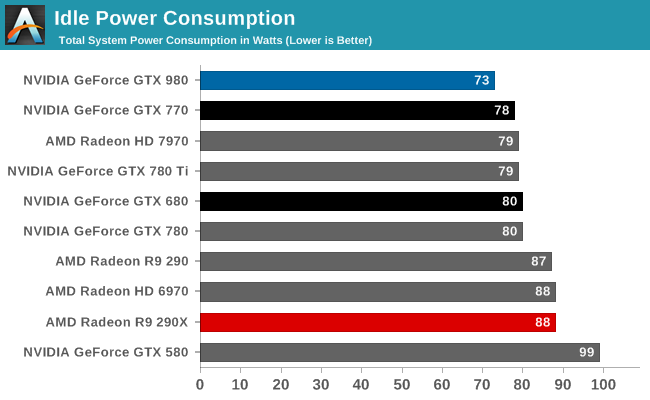
Starting as always with idle power consumption, while NVIDIA is not quoting specific power numbers it’s clear that the company’s energy efficiency efforts have been invested in idle power consumption as well as load power consumption. At 73W idle at the wall, our testbed equipped with the GTX 980 draws several watts less than any other high-end card, including the GK104 based GTX 770 and even AMD’s cards. In desktops this isn’t going to make much of a difference, but in laptops with always-on dGPUs this would be helpful in freeing up battery life.

Our first load power test is our gaming test, with Crysis 3. Because we measure from the wall, this test means we’re seeing GPU power consumption as well as CPU power consumption, which means high performance cards will drive up the system power consumption numbers merely by giving the CPU more work to do. This is exactly what happens in the case of the GTX 980; at 304W it’s between the GK104 based GTX 680 and GTX 770, however it’s also delivering 30% better framerates. Accordingly the power consumption of the GTX 980 itself should be lower than either card, but we would not see it in a system power measurement.
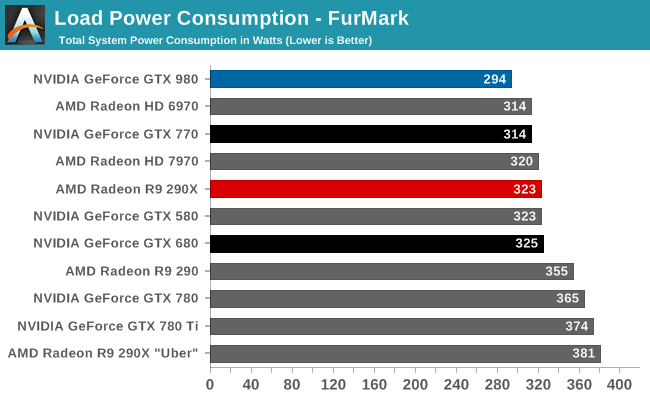
For that reason, when looking at recent generation cards implementing GPU Boost 2.0 or PowerTune 3, we prefer to turn to FurMark as it essentially nullifies the power consumption impact of the CPU. In this case we can clearly see what NVIDIA is promising: GTX 980’s power consumption is lower than everything else on the board, and noticeably so. With 294W at the wall, it’s 20W less than GTX 770, 29W less than 290X, and some 80W less than the previous NVIDIA flagship, GTX 780 Ti. At these power levels NVIDIA is essentially drawing the power of a midrange class card, but with chart-topping performance.
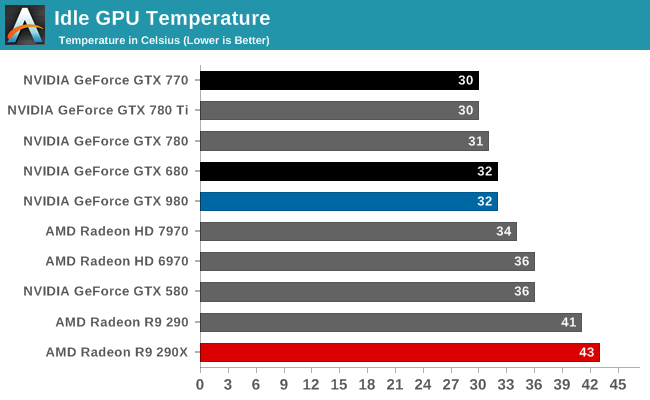
Moving on to temperatures, at idle we see nothing remarkable. All of these well-designed, low idle power designs are going to idle in the low 30s, especially since they’re not more than a few degrees over room temperature.

With an 80C throttle point in place for the GTX 980, it’s here where we see the card top out at. The fact that we’re hitting 80C is the reason why the card is exhibiting clockspeed throttling as we saw earlier. NVIDIA’s chosen fan curve is tuned for noise over temperature, so it’s letting the GPU reach its temperature throttle point rather than ramp up the fan (and the noise) too much.
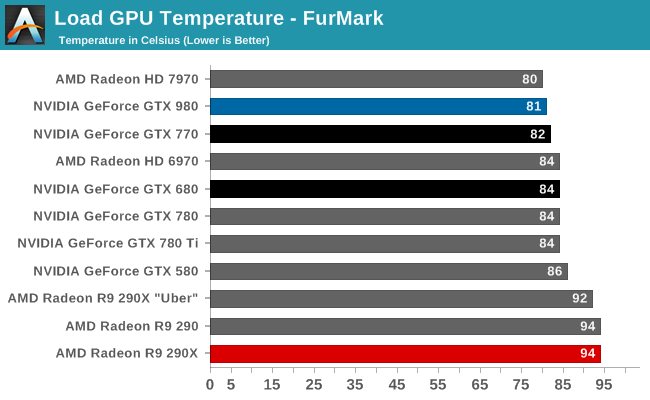
Once again we see the 80C throttle in action. Like all GPU Boost 2.0 NVIDIA cards, NVIDIA makes sure their products aren’t going to get well over 80C no matter the workload.
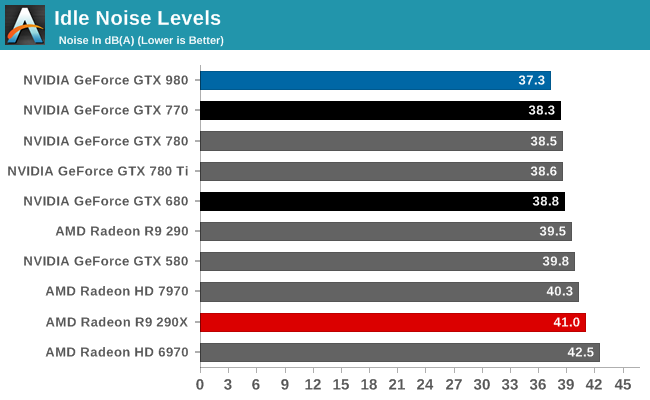
Last but not least we have our noise results. Right off the bat the GTX 980 is looking strong; even with the shared heritage of the cooler with the GTX 780 series, the GTX 980 is slightly but measurably quieter at idle than any other high-end NVIDIA or AMD card. At 37.3dB, the GTX 980 comes very close to being silent compared to the rest of the system.

Our Crysis 3 load noise testing showcases the full benefits of the GTX 980’s well-built blower in action. GTX 980 doesn’t perform appreciably better than the GTX Titan cooler equipped GTX 770 and GTX 780, but then again GTX 980 is also not using quite as advanced of a cooler (forgoing the vapor chamber). Still, this is enough to edge ahead of the GTX 770 by 0.1dB, technically making it the quietest video card in this roundup. Though for all practical purposes, it’s better to consider it tied with the GTX 770.

FurMark noise testing on the other hand drives a wedge between the GTX 980 and all other cards, and it’s in the GTX 980’s favor. Despite the similar noise performance between various NVIDIA cards under Crysis 3, under our maximum, pathological workload of FurMark the GTX 980 pulls ahead thanks to its 165W TDP. At the end of the day its lower TDP limit means that the GTX 980 never has too much heat to dissipate, and as a result it never gets too loud. In fact it can’t. 48.1dB is as loud as the GTX 980 can get, which is why the GTX 980’s cooler and overall build are so impressive. There are open air cooled cards that now underperform the GTX 980 that can’t hit these low of noise levels, never mind the other cards with blowers.
Between the GTX Titan and its derivatives and now GTX 980, NVIDIA has spent quite a bit of time and effort on building a better blower, and with their latest effort it really shows. All things considered we prefer blower type coolers for their heat exhaustion benefits – just install it and go, there’s almost no need to worry about what the chassis cooling can do – and with NVIDIA’s efforts to build such a solid cooler for a moderately powered card, the end result is a card with a cooler that offers all the benefits of a blower with the acoustics that can rival and open air cooler. It’s a really good design and one of our favorite aspects of GTX Titan, its derivatives, and now GTX 980.










274 Comments
View All Comments
nathanddrews - Friday, September 19, 2014 - link
http://www.pcper.com/files/review/2014-09-18/power...kron123456789 - Friday, September 19, 2014 - link
Different tests, different results. That's nothing new.kron123456789 - Friday, September 19, 2014 - link
But, i still think that Nvidia isn't understated TDP of the 980 and 970.Friendly0Fire - Friday, September 19, 2014 - link
Misleading. If a card pumps out more frames (which the 980 most certainly does), it's going to drive up requirements for every other part of the system, AND it's going to obviously draw its maximum possible power. If you were to lock the framerate to a fixed value that all GPUs could reach the power savings would be more evident.Also, TDP is the heat generation, as has been said earlier here, which is correlated but not equal to power draw. Heat is waste energy, so the less heat you put out the more energy you actually use to work. All this means is that (surprise surprise) the Maxwell 2 cards are a lot more efficient than AMD's GCN.
shtldr - Wednesday, September 24, 2014 - link
"TDP is the heat generation, as has been said earlier here, which is correlated but not equal to power draw."The GPU is a system which consumes energy. Since the GPU does not use that energy to create mass (materialization) or chemical bonds (battery), where the energy goes is easily observed from the outside.
1) waste heat
2) moving air mass through the heatsink (fan)
3) signalling over connects (PCIe and monitor cable)
4) EM waves
5) degradation/burning out of card's components (GPU silicon damage, fan bearing wear etc.)
And that's it. The 1) is very dominant compared to the rest. There's no "hidden" work being done by the card. It would be against the law of conservation of energy (which is still valid, as far as I know).
Frenetic Pony - Friday, September 19, 2014 - link
That's a misunderstanding of what TDP has to do with desktop cards. Now for mobile stuff, that's great. But the bottlenecks for "Maxwell 2" isn't in TDP, it's in clockspeeds. Meaning the efficiency argument is useless if the end user doesn't care.Now, for certain fields the end user cares very much. Miners have apparently all moved onto ASIC stuff, but for other compute workloads any end user is going to choose NVIDIA currently, just to save on their electricity bill. For the consumer end user, TDP doesn't matter nearly as much unless you're really "Green" conscious or something. In that case AMD's 1 year old 290x competes on price for performance, and whatever AMD's update is it will do better.
It's hardly a death knell of AMD, not the best thing considering they were just outclassed for corporate type compute work. But for your typical consumer end user they aren't going to see any difference unless they're a fanboy one way or another, and why bother going after a strongly biased market like that?
pendantry - Friday, September 19, 2014 - link
While it's a fair argument that unless you're environmentally inclined the energy savings from lower TDP don't matter, I'd say a lot more people do care about reduced noise and heat. People generally might not care about saving $30 a year on their electricity bill, but why would you choose a hotter noisier component when there's no price or performance benefit to that choice.AMD GPUs now mirror the CPU situation where you can get close to performance parity if you're willing to accept a fairly large (~100W) power increase. Without heavy price incentives it's hard to convince the consumer to tolerate what is jokingly termed the "space heater" or "wind turbine" inconvenience that the AMD product presents.
Laststop311 - Friday, September 19, 2014 - link
actually the gpu's from amd do not mirror the cpu situation at all. amd' fx 9xxx with the huge tdp and all gets so outperformed by even the i7-4790k on almost everything and the 8 core i7-5960x obliterates it in everything, the performance of it's cpu's are NOT close to intels performance even with 100 extra watts. At least with the GPU's the performance is close to nvidias even if the power usage is not.TLDR amd's gpu situation does not mirror is cpu situation. cpu situation is far worse.
Laststop311 - Friday, September 19, 2014 - link
I as a consumer greatly care about the efficinecy and tdp and heat and noise not just the performance. I do not like hearing my PC. I switched to all noctua fans, all ssd storage, and platinum rated psu that only turns on its fan over 500 watts load. The only noise coming from my PC is my radeon 5870 card basically. So the fact this GPU is super quiet means no matter what amd does performance wise if it cant keep up noise wise they lose a sale with me as i'm sure many others.And im not a fanboy of either company i chose the 5870 over the gtx 480 when nvidia botched that card and made it a loud hot behemoth. And i'll just as quickly ditch amd for nvidia for the same reason.
Kvaern - Friday, September 19, 2014 - link
"For the consumer end user, TDP doesn't matter nearly as much unless you're really "Green""Or live in a country where taxes make up 75% of your power bill \